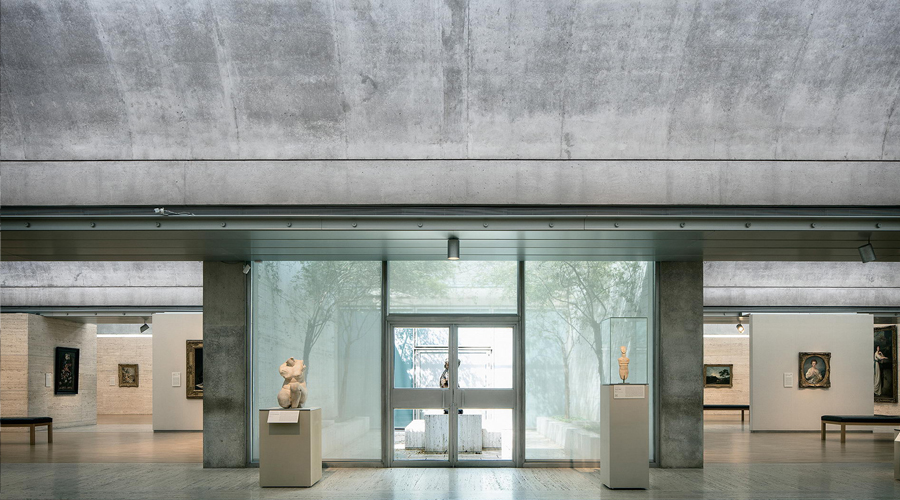El Croquis 78 STEVEN HOLL 1986-1996
如果有人读了你们的文章,就会认为你们对建筑的主观知觉很感兴趣。但是在你对实践的描述中,你似乎对项目的内在结构也很感兴趣。如果对建筑的本体更感兴趣,而不是它的表征潜力,你可以选择两条路径:要么让建筑展现出非凡的知觉体验,要么相信建筑是自足的,它在某种程度上独立于它被感知的方式。并不是说这两种方式是相互排斥的,而是想知道你如何更准确地表达它们。在这方面,你提到路易斯·康是令人困惑的,因为人们会认为他不会在感性的、现象的项目方面做出很多让步……
我不同意这种说法。金贝尔艺术博物馆也是关于感知的。现在有一些建筑师感兴趣的是建筑操作,而不是项目如何被感知感,但我不认为康是这种态度的一个很好的例子。与哲学、艺术或语言理论不同,建筑具有与每个人联系的潜能。他们是否理解这种联系的深度是另一个问题。但如果一座建筑真的很强劲,人们会在很多层面上做出反应,不仅是知识分子,还包括触碰到墙的五岁小孩。对我来说,这非常令人兴奋,这是真正的挑战。
我们现在正在为密歇根州布卢姆菲尔德山的克兰布鲁克科学研究所加建一个博物馆。谁来参观了? 底特律的小学生,六十人坐在一辆巴士上。除了我欣赏这个建筑的含义,你还可以说教,还有其他理解建筑的方式。也许最常见的是通过直接的空间或物质体验,任何人都能感受到。所以,你的问题是循环的——形式和内容哪个更重要?
当然,但是我认为想法可以有不同的来源,我想知道你是如何产生你的想法的。有些建筑师通过操纵符号或制作功能图解来产生想法。我想发现的是,你的想法是否来自于研究在潜在使用者的预期体验,还是来自于材料或功能组织的内部逻辑……
我想说的是,我对思想的哲学本质非常感兴趣,但我不能就此打住。我的努力是试图找到这个想法惊人的潜力。例如,在福冈的案例中,有两个想法在起作用。一个是个性化公寓的铰接空间,与日本传统的家庭空间相关。第二个概念是没有功能的虚空空间——它只是一个有水池的虚空,像一个现象一样,将天空的所有属性,光、影、风、雨,反射回公寓。这个建筑只有两个概念,你不能把其中一个拿走,因为它们相互影响。我希望通过概念策略将现象属性联系起来。

lf one reads your texts, one would think that you are fundamentally interested in operating on the perceptual qualities of the architecture. But in your description of your practice, you seem to be also very interested in a kind of structural nature of the projects. Being interested more in the artifactual nature of architecture, rather than in its representational potential, one could follow two alternative paths: to operate either on the phenomenal qualities of the project, or to believe that the project has an internal structural quality that is to some extent independent of the way in which it is perceived. Not that both ways are mutually exclusive, but / would like to know more precisely how do you articulate them.Your reference to Louis Kahn is confusing in this respect,because one would think that he would not make many concessions to the perceptual,phenomenal side of the projects…
l would disagree. The Kimbell Art Museum is also about perception. l think there are some architects working today who are interested in the degree of experimentation and not in how the project is actually perceived, but l don’t think Kahn is a good example of this attitude. Architecture,unlike philosophy, art,or linguistic theory, has the potential to connect to everyone. Whether or not they understand the depth of this connection is another question. But if a building is really strong, people will respond on many levels; not only the intellectuals but also a five year old child who just touches the wall. To me this is very exciting,this is the real challenge.
We are making now a Museum addition to the Cranbrook Institute of Science in Bloomfield Hills,Michigan. Who comes there? School kids from the Detroit school system -sixty on a bus. Beyond the architectural implications of the project,that l may appreciate,or that you can teach, there are other ways of understanding architecture. And maybe the most frequent one occurs through direct spatial or material experience,which can be felt by anyone. So, your question is circular -what is more important,form or content?
Sure, but l think ideas can have different origins,and l am trying to find how do you produce your ideas.There are architects that make ideas through manipulating symbols, or through making programmatic diagrams. What l am trying to find is whether your ideas emerge from a desired phenomenal effect of the work in the potential users, or from an internal logic of material or programmatic organization…
l would say that l am very interested in the philosophical nature of ideas as an origin, but l couldn’t just stop there. My struggle is to try to find the phenomenal potential of the idea. For example,in the case of Fukuoka,there are two ideas at work; one is the hinged space of the individuated apartments,which connects to ancient Japanese domes-tic space.The second concept is void space which has no function —it is just a void with a pond of water which reflects,like a phenomenallens, all the properties of the sky,the light,the shadow,the wind,the rain, back into the apartments.There are only two concepts in this building,and you can’t take one of the them away because they interact with each other. I hope to connect to phenomenal properties with the conceptual strategy.

[…] 斯蒂文·霍尔 Steven Holl […]